.

How to Spot and Treat Light Burn on Your Cannabis Plants
Light burn is an issue that indoor growers sometimes find themselves facing. But just how serious is this condition? Read on as we explain whether it's possible to provide your cannabis plants with too much light and how to spot, fix, and prevent light stress in your crop.
Contents:
Key Points:
- Cannabis cannot get "too much" light
- Light stress can be easily diagnosed with the right knowledge
- Light burn is simple to remedy
- So long as it's treated quickly, light stress will not cause lasting damage
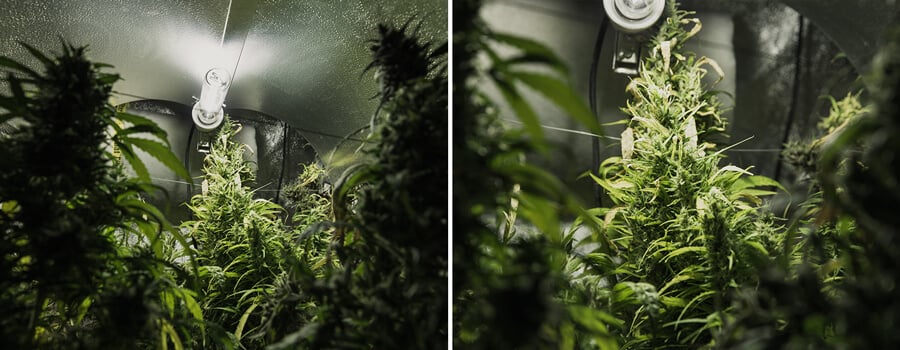
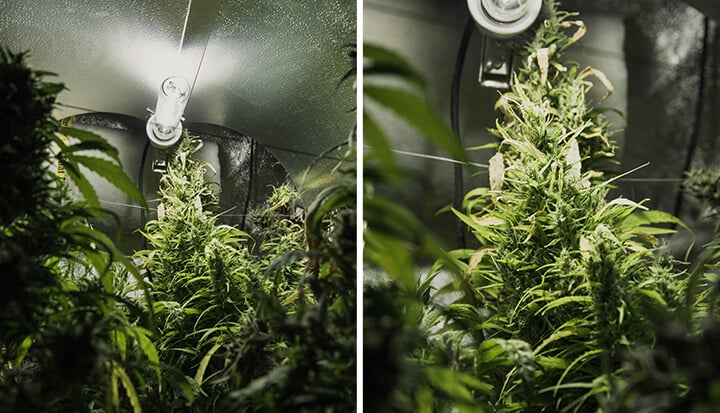
Light stress chiefly impacts indoor cannabis plants. Within this environment, growers are tasked with balancing a host of variables, including the distance of the grow lamp from the canopy and its intensity. Position your lamp too close, and you’ll encourage light burn. Place it too far away, and your plants will underperform and stretch undesirably toward the source.
Whether you’re a novice grower wondering how to fix light stress or a veteran cultivator looking to enhance your knowledge, you’ll learn everything you need to know about light burn below.
To start things off, you should know that plants technically cannot receive “too much” light; photons themselves are not the issue. Rather, an imbalance between lighting and the other resources that cannabis requires leads to light stress—the demand for water, carbon dioxide, and nutrients increases in step with light intensity.
If you hang an overly powerful light over your plant but fail to adjust these parameters, you’re going to run into trouble (in the form of light stress). Additionally, it’s the heat emitted from the light, rather than the photons themselves, that causes light burn. Position your light incorrectly, and you’ll literally cook the upper portions of the canopy.
With that cleared up, let’s take a look at the signs of light stress, how to solve it, and how to prevent light burn in the first place.
Signs of Too Much Light on Cannabis Plants
How can you tell if your plants are suffering from cannabis light burn or light stress? Well, if you know what to look for, you can diagnose the problems quite quickly. Here’s what to keep an eye out for when diagnosing light stress in weed.
-
Bleached Buds
One surefire symptom of light burn is bleaching of the flowers. This phenomenon occurs when flowers are located too close to high-powered lights. You may have seen images online of pure white “albino” cannabis flowers. While they might look like the intentional development of rare genetics, most of the time, this is simply bleaching.
Healthy buds typically exhibit rich green tones with hints of orange or purple, depending on the strain. In contrast, bleached buds are unnaturally white. The heat also degrades cannabinoids present in the resin, which causes buds to lose potency. The scent and taste of these buds will also be less than desirable. The terpenes responsible for these traits are highly volatile, and excess heat will also cause them to degrade. In short, bleached buds lack character on all fronts, whereas healthy buds are aromatic and rich in color.
-
Yellow Leaves
Yellow leaves are another sign that your plant is being subjected to light burn. However, yellow leaves can also signify nutrient problems like nitrogen deficiency. The difference lies in the pattern and progression of the symptoms:
- Light burn: Yellowing starts at the top of the plant where the leaves are closest to the light. These leaves remain firm and are difficult to remove.
- Nitrogen deficiency: Yellowing begins at the bottom of the plant. The leaves exhibit significant wilting and are easy to pluck away.
Understanding this distinction will help you to act appropriately to address the root cause of yellowing leaves and ensure you don’t go for the wrong treatment.
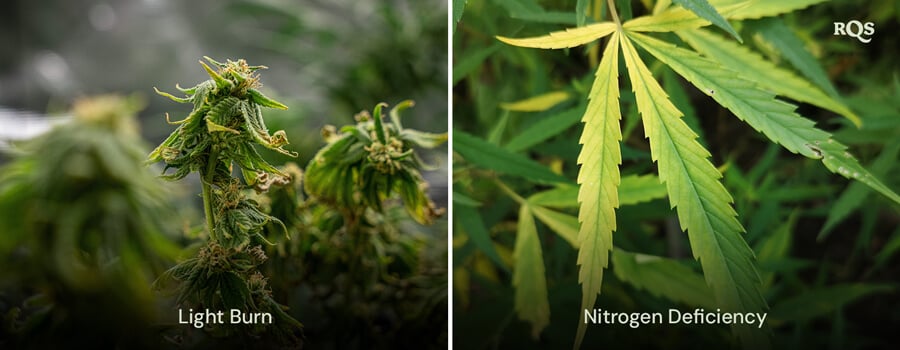
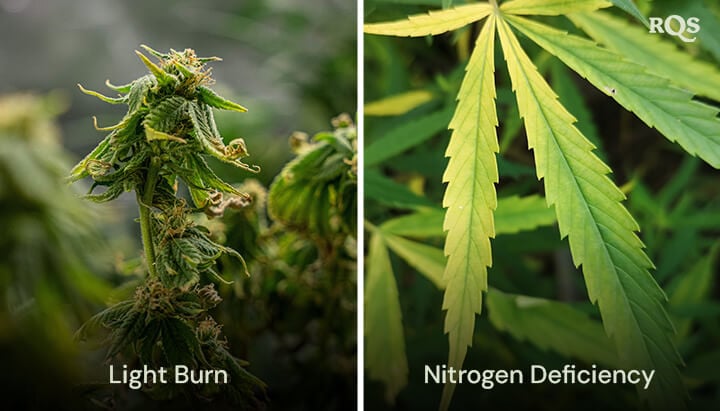
-
Stunted Growth
Light burn can reduce the rate of growth due to damage inflicted upon the photosynthetic apparatus. Burned leaves lose their water content, shrivel up, and turn yellow. Without water, structural integrity, and chlorophyll, affected leaves cannot conduct photosynthesis, which hampers plant development.
In the long term, stunted growth can directly impact yields. Fewer healthy leaves mean less energy production for flower formation, reducing overall crop potential. This will affect both the size of the yield and the quality of the buds harvested.
-
Symptom Overlap with Other Problems
Distinguishing light burn from other common issues can be challenging. Here’s how to differentiate it from similar conditions:
- Heat stress: Heat stress causes similar symptoms, like wilting and curling leaves, but it often affects plants more uniformly rather than just the topmost parts.
- Overwatering: This causes drooping and yellowing of leaves from the bottom up. Eventually, the entire plant will appear lifeless.
- Nutrient burn: Symptoms include burnt leaf edges and tips, often accompanied by dark green foliage. This will affect the whole plant, which is what differentiates it from light burn.
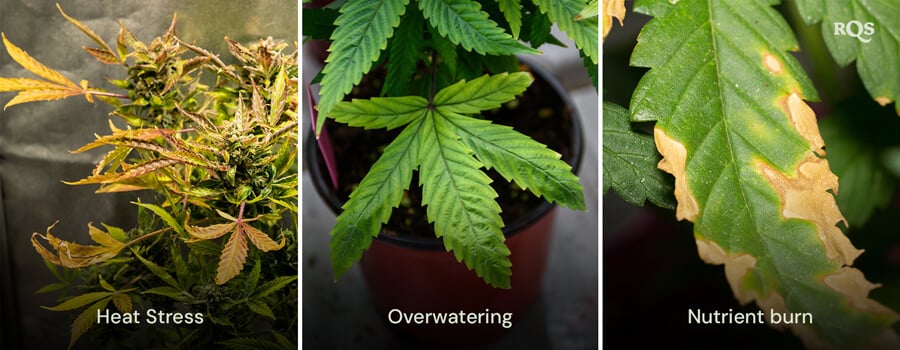
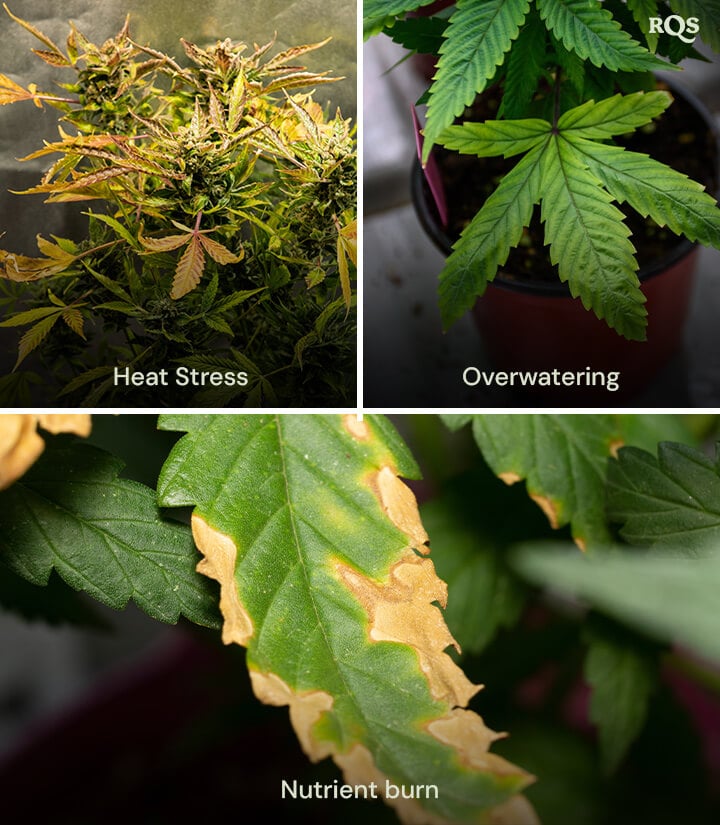
How to Solve Weed Light Burn
The first thing you should do is move your plants a bit further away from the lights. This can either be done by moving the plants or by moving the lights, if you have the space. Take into consideration the most affected areas of each plant when choosing a new location for them. You can also remove some of your lights. If you have these well organized, it shouldn't hurt your plants to remove a few bulbs.
If reducing the light or moving the plants isn't an option, you can always opt to low-stress train your plants. This is a technique for obtaining higher yields while limiting plant stature; the goal is to keep the plant's branches all at the same height. As the stem gets taller, it is bent sideways and kept in that position with an external aid.
Try decreasing the temperature of the room too. Do this very slowly and always keep the temperature consistent. The plant will need time to adjust. Any change you make to a plant's environment or medium needs to be done carefully and patiently. It doesn't matter how well you water and feed your plants; if you don't take proper care of the environment, the plants will die.
To aid temperature control, you can use fans or air conditioning. Fans will increase air circulation and stop hot pockets from appearing, whereas AC will both circulate air and introduce cooler air into the environment, which can be very helpful if the grow is too hot.
How to Prevent Too Much Light for Plants
Now, let’s explore how to avoid providing too much light to begin with. The distance between your light and your plant(s) remains key here. It all boils down to the type of light in question. Typically, most indoor home growers achieve good results with a power distribution of 400–600W per yd².
When using a metal halide (MH) or high-pressure sodium (HPS) lamp within this power range, aim for these distances:
If you prefer light-emitting diodes (LEDs), then position your lights within these ranges:
<span" style="color: #000000;">You can also use a lux meter to gauge where to place your lights. The metric of lux (lumens/m²) can help growers nail light positioning further and thereby optimize plant performance. Aim for these lux ranges during the three main stages of the growing cycle:
-
Role of Reflective Surfaces
Using reflective surfaces like Mylar sheets or panda foil enhances light distribution, ensuring even coverage. This reduces hot spots and minimizes the risk of light burn on specific parts of the plant while also making your lights more efficient.
-
Using Light Measurement Tools
Light measurement tools like lux meters or PAR meters can help growers optimize light placement. Lux meters measure lumens per square meter and are useful for gauging light intensity; you can use these to find the optimal placement for your lights. PAR meters, on the other hand, provide readings of photosynthetically active radiation (PAR), helping growers deliver light effectively for photosynthesis.
These two tools are slightly different and aren’t necessary for the casual grower, but they can help to optimize your setup and avoid problems including light stress.
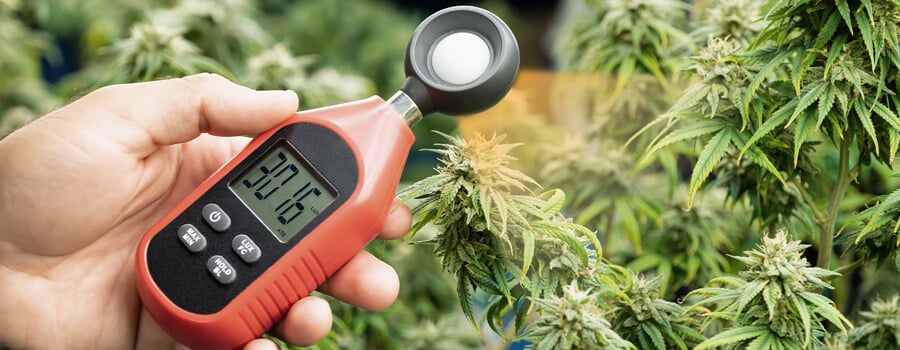
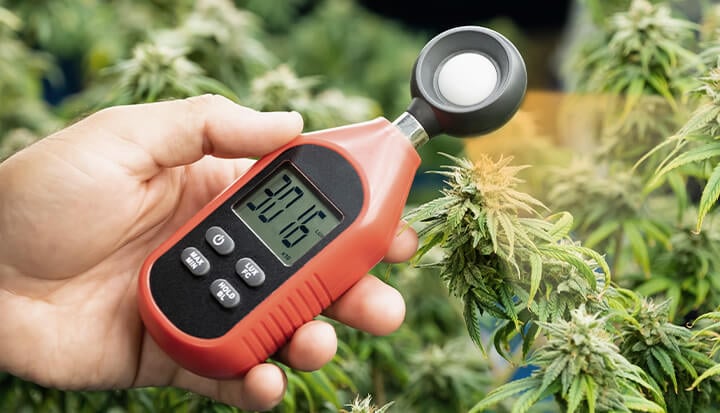
Can Plants Get Too Much Light?
You can indeed expose cannabis plants to too much light if you don’t have additional resources to help them handle this stimulus. Below, we cover optimal light cycles, more technical terminology when it comes to measuring light, and why you need to think about space before investing in a grow lamp.
-
18-Hour vs 24-Hour Light Cycles
How much light should you provide to your plants during different stages of growth? Photoperiod plants need 18–24 hours of light during veg and 12 hours of light during bloom to remain in the flowering stage. Autoflowering plants can receive 18–24 hours of light during the entire growing cycle, as they don’t require a certain light schedule to initiate flowering.
But which cycle should you opt for during the photoperiod veg stage and the entire autoflowering life cycle?
A debate rages around this topic. Some growers note excellent results when maxing out the light cycle, whereas others claim it makes little to no difference. However, because light drives photosynthesis and photosynthesis drives growth, you can expect to see a faster rate of growth when keeping your lamp on for 24 hours each day.
So, why don’t all growers follow this strategy? There are two main reasons. First and foremost, it costs more to run a lamp for this amount of time. If you grow cannabis indoors all year long, you’re looking at a substantial increase in your electricity costs. Second, increased photosynthesis and growth require higher quantities of water and nutrients. The longer you keep your lamp running, the more you have to tend to your plants’ needs across different phases of growth.
PPFD and Lux Meters Explained
We’ve briefly touched on lux meters—devices that measure the amount of lumens across a particular surface area. While some growers value this metric, it doesn’t tell us the whole picture. Why? Because lumens are a measure of light visible to the human eye. However, our eyes are only sensitive to a portion of the spectrum that plants use for photosynthesis.
Therefore, many cultivators prefer to measure photosynthetically active radiation (PAR)—the range of photons that plants convert into energy. This is done by measuring photosynthetic photon flux density (PPFD) using a PAR meter. These devices inform growers of the amount of photosynthetically useful light hitting an area of 1 square meter per second (µmols/m²/s). Aim for a PAR level of between 300–400 µmols/m²/sec when positioning your lamp.
-
More Light Means More Resources
If you want faster growth over a shorter period, it makes sense to use a stronger light. However, this benefit comes at a cost. An increased metabolism through higher rates of photosynthesis means you’ll have to match PPFD with other plant demands. These include:
- More nutrients: Your plant will require higher levels of key nutrients, particularly nitrogen, when under more powerful lights. Increase your weekly dose if you’re using synthetic nutes. If you’re an organic grower, liquid seaweed and fish emulsion are good sources.
- More water: You’ll need to keep a keen eye on plant hydration. Observe frequently for a loss of turgidity, and water every time the top inch of the growing medium dries out.
- Dial in temperature and humidity: Stronger lights give off more heat. Use fans to help reduce excessive temperatures and a humidifier to stop foliage from getting too dry.
- Consider carbon dioxide: Using stronger lights will give you the opportunity to leverage supplemental CO₂. This combination can increase plant resistance, speed up growth, and result in better yields.
-
Match Lighting with Space
Ultimately, you also need to match the light with the space you’re growing in. Select a light that’s compatible with your growing space. For example:
- Small spaces: Use a 200W LED
- Larger spaces: Opt for stronger lights like a 600W LED
If you use too big of a light in a small space, you won’t be supercharging your plant; you’ll just be stressing it out and either burning it or otherwise giving it an unquenchable thirst for water and nutrients. So it’s all about finding a balance between the space, the plants, and your ability to care for them.
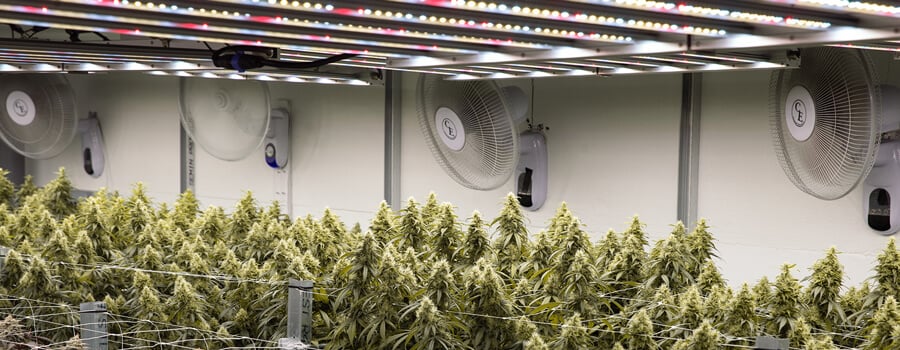
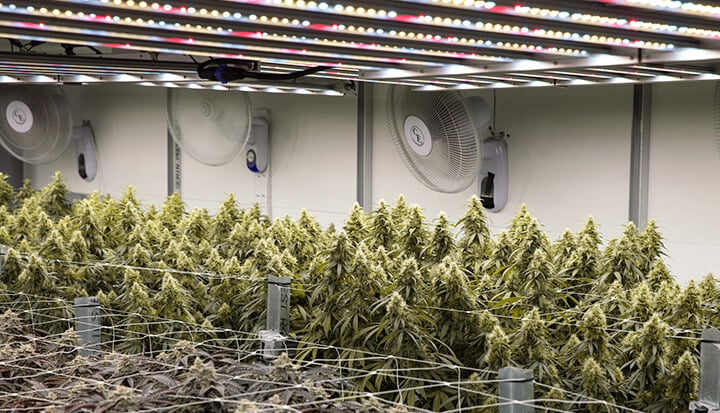
How Much Light Does a Cannabis Plant Need?
Cannabis plants need enough photons to survive, but they can handle plenty more than this. As mentioned, technically, cannabis plants cannot receive too much light. Autoflowers and vegging photoperiod feminized strains will thrive under a powerful light source for 24 hours each day, provided they receive enough nutrients, airflow, water, and humidity to deal with the sharp rise in metabolic processes.
However, most home growers strike a balance between optimal performance, energy costs, and plant health. To achieve this, just follow the recommendations above for light distance, lux, and PAR. Happy growing!






































